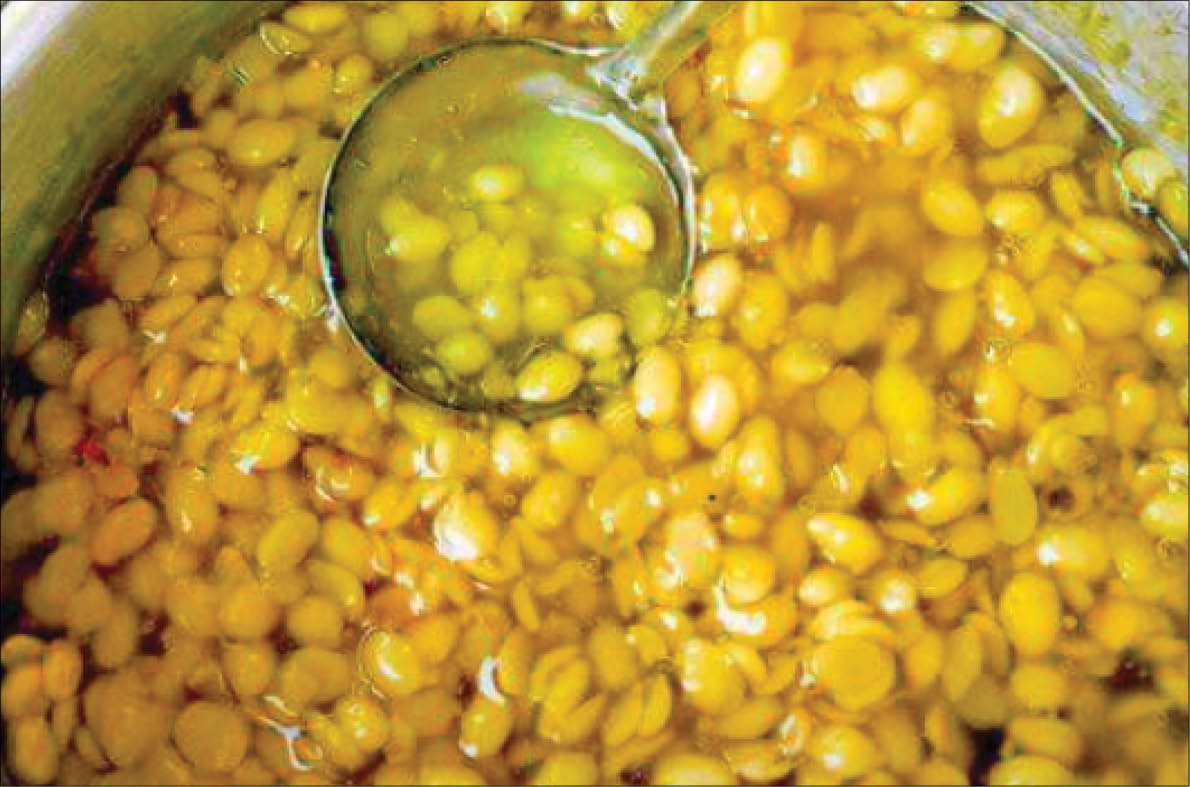Now is true spring weather. After a while, my stomach started grumbling and the sudden hunger reminded me that I hadn’t had lunch yet. Stopping by the red light, looking across the corner of Phu Xuan bookstore, there were two street stalls of two old grandmothers on the corner. One grandma sold sweet potatoes, cassavas and boiled bananas. And the other, older with freckled cheeks and wrinkled mouth corners, was selling red bean and hyacinth bean sweet soups.

Hyacinth bean sweet soup, a sweet childhood gift
I stopped by to buy two bags of hyacinth bean sweet soup. Looking at the familiar bag of sweet soup, suddenly my childhood memories flushed back – memories of my grandma’s hyacinth bean sweet soup shop.
Now, no one makes hyacinth bean sweet soup in the old fashion way, with brown sugar to achieve a dark golden color. White sugar is now too cheap, and people use white sugar for convenience. And perhaps, in the whole city of Hue now, only this grandmother makes hyacinth sweet soup in this way.
Back when I was an elementary school girl, my mother used to bring me to my grandma’s home. And every day, I was treated with grandma’s hyacinth bean sweet soup that she made to sell. When I was nine or ten years old, I had learnt by heart grandma’s hyacinth bean sweet soup recipe.
First, my grandma would soak the beans in water. The dried beans were put in cold water and soaked overnight until they became soft and had expanded. As with anything soaked overnight, my grandma would usually take a banana leaf and lay it across the top of the container.
In the morning, my grandmother would wake up at five o’clock. She would take the soaked beans and boil them for a bit. The cooked beans were then put in cold water and the next stage was peeling the beans. This was the most time-consuming step because every single bean had to be peeled carefully, throwing away the outer layer and keeping the inner core. I was often allowed to get involved in this stage. To remove the beans, it usually took at least two hours.
When the beans are peeled, grandma would wash the beans several times to get rid of the sprouts. Once the water ran clear, she would begin to steam the beans. Before putting the beans in a steamer, she never forgot to put a layer of pineapple leaves underneath for the pleasant aroma.
While waiting for the beans to cook, she lighted another stove and prepared to cook the sugar water. She put the brown sugar into the saucepan and poured water in. She waited until the sugar water started boiling and added some vanilla extract to enhance the aroma. Afterward, she took a lump of cassava flour and mixed with water. Then she poured into the sugar water mixture to thicken the sugar water.
When the beans are cooked, grandma poured them on a basket and then slowly added to the sugar water. As she poured in the beans, she used a pair of chopsticks to evenly and carefully stir so as to not break the beans. After that, she put it on the stove to boil again. The final stage was scooping out the sweet soup into glasses to sell to passersby.
Grandma’s sweet soup shop was located along the road, so some aunties on the way to the market often stopped by for a glass of sweet soup and to tell each other the village news. And, grandma’s sweet soup shop was also on my way to school, so whether I was going to stay over at grandma’s or not, grandma always gave me a bag of sweet soup so I could eat on the way to school.
Now my grandma is nearly ninety years old, the sweet soup shop had been closed for a long time. But sometimes, I still crave grandma’s hyacinth bean sweet soup, a gift from my sweet childhood. And this afternoon, I was able to revisit a beautiful childhood memory with this golden hyacinth bean sweet soup.
Story and photos: Nam Giao